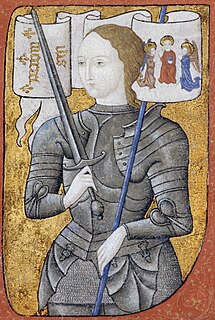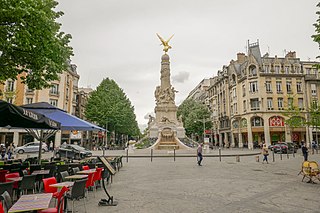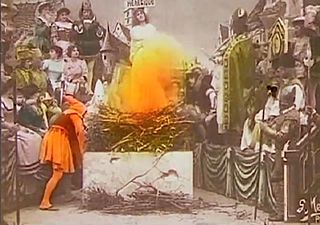Related Research Articles

Joan of Arc, nicknamed "The Maid of Orléans" or "Maid of Lorraine", is considered a heroine of France for her role during the Lancastrian phase of the Hundred Years' War, and was canonized as a saint. She was born to Jacques d'Arc and Isabelle Romée, a peasant family, at Domrémy in the Vosges of northeast France. Joan said that she received visions of the archangel Michael, Saint Margaret, and Saint Catherine of Alexandria instructing her to support Charles VII and recover France from English domination late in the Hundred Years' War. The as-yet-unanointed King Charles VII sent Joan to the siege of Orléans as part of a relief army. She gained prominence after the siege was lifted only nine days later. Several additional swift victories led to Charles VII's consecration at Reims. This long-awaited event boosted French morale and paved the way for the final French victory at Castillon in 1453.

The Medieval Inquisition was a series of Inquisitions from around 1184, including the Episcopal Inquisition (1184–1230s) and later the Papal Inquisition (1230s). The Medieval Inquisition was established in response to movements considered apostate or heretical to Roman Catholicism, in particular Catharism and Waldensians in Southern France and Northern Italy. These were the first movements of many inquisitions that would follow.

Reims is the most populous city in the department of Marne. Its population in 2013 was 182,592 in the city proper and 317,611 in the surrounding metropolitan area, making Reims the most populated sub-prefecture in France. The city lies 129 km (80 mi) east-northeast of Paris. Its primary river, the Vesle, is a tributary of the Aisne.

Cardinal Henry Beaufort, Bishop of Winchester, was an English prelate and statesman who held the offices of Bishop of Lincoln (1398) then Bishop of Winchester (1404) and was from 1426 a Cardinal of the Church of Rome. He served three times as Lord Chancellor and played an important role in English politics.

The Passion of Joan of Arc is a 1928 French silent historical film based on the actual record of the trial of Joan of Arc. The film was directed by Carl Theodor Dreyer and stars Renée Jeanne Falconetti as Joan. It is widely regarded as a landmark of cinema, especially for its production, Dreyer's direction and Falconetti's performance, which is often listed as one of the finest in cinema history. The film summarizes the time that Joan of Arc was a captive of England, depicting her trial and execution.

Philip the Good was Duke of Burgundy from 1419 until his death. He was a member of a cadet line of the Valois dynasty, to which all 15th-century kings of France belonged. During his reign, the Burgundian State reached the apex of its prosperity and prestige, and became a leading centre of the arts. Philip is known in history for his administrative reforms, his patronage of Flemish artists such as van Eyck and Franco-Flemish composers such as Guillaume Du Fay, and the capture of Joan of Arc and turning her over to the English, who tried and executed her. In political affairs, he alternated between alliances with the English and the French in an attempt to improve his dynasty's powerbase. Additionally, as ruler of Flanders, Brabant, Limburg, Artois, Hainaut, Holland, Luxembourg, Zeeland, Friesland and Namur, he played an important role in the history of the Low Countries.

St. Joan of Arc Chapel is a Roman Catholic chapel today located in Milwaukee, Wisconsin, United States, on the campus of Marquette University, in the Archdiocese of Milwaukee. It was dedicated to St. Joan of Arc on 26 May 1966, after it had been moved from its previous location on Long Island, New York. It was originally built in the Rhône River Valley in France.

The Messenger: The Story of Joan of Arc is a 1999 English-language French epic historical drama film directed by Luc Besson. The film stars Milla Jovovich, John Malkovich, Faye Dunaway and Dustin Hoffman. The screenplay was written by Besson and Andrew Birkin, and the original music score was composed by Éric Serra.

Joan of Arc is a 1900 French silent film directed by Georges Méliès, based on the life of Joan of Arc.

Personal Recollections of Joan of Arc, by the Sieur Louis de Conte is an 1896 novel by Mark Twain which recounts the life of Joan of Arc. It is Twain's last completed novel, published when he was 61 years old.

Giovanna d'Arco is an operatic dramma lirico with a prologue and three acts by Giuseppe Verdi set to an Italian libretto by Temistocle Solera, who had prepared the libretti for Nabucco and I Lombardi. It is Verdi's seventh opera.

Joan of Arc has inspired artistic and cultural works for nearly six centuries. The following lists cover various media to include items of historic interest, enduring works of high art, and recent representations in popular culture. The entries represent portrayals that a reader has a reasonable chance of encountering rather than a complete catalog. Lesser known works, particularly from early periods, are not included. In this article, many of the excluded items are derivative of better known representations. For instance, Friedrich Schiller's 1801 play The Maid of Orleans inspired at least 82 different dramatic works during the nineteenth century, and Verdi's and Tchaikovsky's operatic adaptations are still recorded and performed. Most of the others survive only in research libraries. As another example, in 1894, Émile Huet listed over 400 plays and musical works about Joan of Arc. Despite a great deal of scholarly interest in Joan of Arc, no complete list of artistic works about her exists, although a 1989 doctoral dissertation did identify all relevant films including ones for which no copy survives.

There are a number of revisionist theories about Joan of Arc which contradict the established account of her life. These include the theory that she was in fact guilty of the heresy for which she was condemned; that bones and other alleged relics come from her; that she escaped death at the stake and lived out her life in secret.
Françoise Meltzer is a professor of Philosophy of Religion at the University of Chicago Divinity School. She is also the Edward Carson Waller Distinguished Service Professor of the Humanities and Chair of Comparative Literature at the University of Chicago.

Joan of Arc did not come from a place called Arc, but was born and raised in the village of Domrémy in what was then the northeastern frontier of the Kingdom of France. In the English language her first name has been repeated as Joan since the fifteenth century because that was the only English equivalent for the feminine form of John during her lifetime. Her surviving signatures are all spelled Jehanne without surname. In French her name is today always rendered as Jeanne d'Arc, reflecting the modern spelling of her first name. The surname of Arc is a translation of d'Arc, which itself is a nineteenth-century French approximation of her father's name. Apostrophes were never used in fifteenth-century French surnames, which sometimes leads to confusion between place names and other names that begin with the letter D. Based on Latin records, which do reflect a difference, her father's name was more likely Darc. Spelling was also phonetic and original records produce his surname in at least nine different forms, such as Dars, Day, Darx, Dare, Tarc, Tart or Dart.

Sancoins is a commune in the Cher department in the Centre-Val de Loire region of France.

Bonsecours is a commune in the Seine-Maritime department in the Normandy region in northern France.

The Maid of Orleans is a satirical poem by François-Marie Arouet, better known by his pen name, Voltaire. It was first published in 1899, but Voltaire had written it over a century beforehand; while he had started writing the text in 1730, he never completed it. It was translated into English by W. H. Ireland.

Louis-Maurice Boutet de Monvel was a French painter and illustrator best known for his watercolours for children's books. He was a major figure in nineteenth-century children's book illustration.

Joan of Arc is a 1922 cast of Paul Dubois's 1889 statue of Joan of Arc, located at Meridian Hill Park in Washington, D.C., United States of America. Joan of Arc was originally surveyed as part of the Smithsonian's Save Outdoor Sculpture! survey in 1994.
References
- ↑ de Julleville, Louis Petit (1901). Joan of Arc. Original from Harvard University: Duckworth. p. 30.
- ↑ Nineteenth Century (1895). The Twentieth Century. Original from the University of California: The Nineteenth Century and After Limited. p. 870.